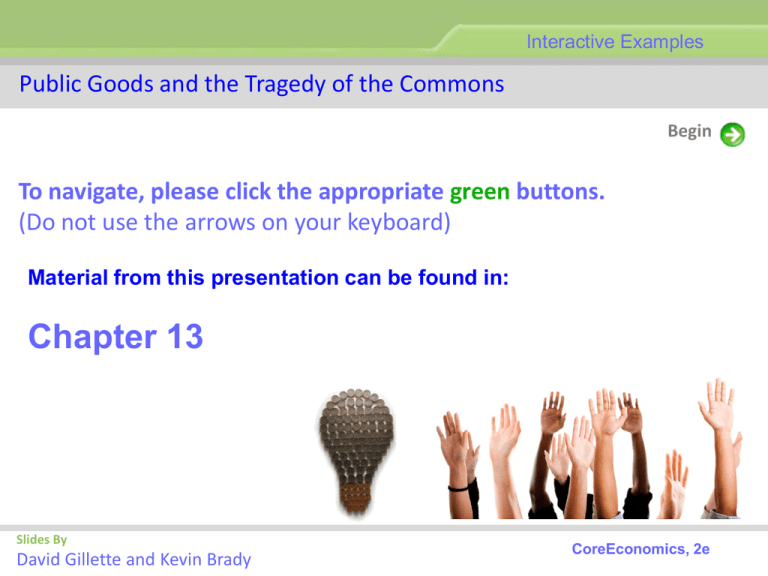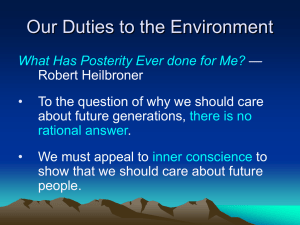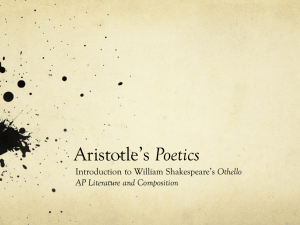Chapter 13_Public Goods - Worth Publishers Blogs
advertisement

Interactive Examples Public Goods and the Tragedy of the Commons Begin To navigate, please click the appropriate green buttons. (Do not use the arrows on your keyboard) Material from this presentation can be found in: Chapter 13 Slides By David Gillette and Kevin Brady CoreEconomics, 2e Interactive Examples Public Goods and the Tragedy of the Commons QUESTION ONE Which of the following could be used to illustrate the nature of a public good? a) A can of soda. b) A lighthouse. c) A bike trail in a city park. Hint Answer Interactive Examples Public Goods and the Tragedy of the Commons QUESTION ONE Which of the following could be used to illustrate the nature of a public good? a) A can of soda. b) A lighthouse. HINT: Think of the how the characteristics of nonrivalry and nonexcludability are applied to each of these goods. c) A bike trail in a city park. Interactive Examples Public Goods and the Tragedy of the Commons QUESTION ONE Next Which of the following could be used to illustrate the nature of a public good? a) A can of soda. b) A lighthouse. c) A bike trail in a city park. ANSWER: a) A can of soda is a private good; it is both rival and exclusive. b) The services of a lighthouse are both nonrival and nonexclusive, making it a pure public good. c) A bike trail in a city park is nonexclusive, but it is rival. Only so many bikers can use it at the same time. The only good from the three listed that can be used to illustrate the nature of a public good is the lighthouse. Interactive Examples Public Goods and the Tragedy of the Commons QUESTION TWO Think about the last DVD movie you purchased. As which of the four types of goods below should it be classified? a) A pure private good b) A public good with exclusion c) A common property resource d) A pure public good Hint Answer Interactive Examples Public Goods and the Tragedy of the Commons QUESTION TWO Think about the last DVD movie you purchased. As which of the four types of goods below should it be classified? a) A pure private good b) A public good with exclusion c) A common property resource d) A pure public good HINT: How does a DVD movie fare when the nonrival and nonexcludable concepts are applied to it? Interactive Examples Public Goods and the Tragedy of the Commons QUESTION TWO Think about the last DVD movie you purchased. As which of the four types of goods below should it be classified? a) A pure private good b) A public good with exclusion c) A common property resource d) A pure public good ANSWER: Next Let’s consider both the nonexcludability and nonrivalry attributes of a DVD movie. The copy of a DVD movie that you purchase and bring home is certainly exclusive. Only those people you allow into your home, or to whom you lend it, will be able to view the movie. Now that we know the DVD movie is exclusive, is it rival or nonrival in consumption? Does your viewing it reduce or prohibit anyone else's ability to view the movie? The ability for someone else to view the movie with you is only limited by the size of your room and capability of your entertainment system, not by the DVD movie itself. It is also true that your viewing the movie does not reduce the ability of subsequent viewing by someone else. Your ability to exclude others from viewing your copy of the movie along with your ability to invite others to view it with you makes your copy of a DVD movie a public good with exclusion. Interactive Examples Public Goods and the Tragedy of the Commons QUESTION THREE Consider the flu vaccination that thousands of people, but not everyone, get each year as the flu season begins. As which of the four types of goods below should it be classified? a) A pure private good b) A public good with exclusion c) A common property resource d) A pure public good Hint Answer Interactive Examples Public Goods and the Tragedy of the Commons QUESTION THREE Consider the flu vaccination that thousands of people, but not everyone, get each year as the flu season begins. As which of the four types of goods below should it be classified? a) A pure private good b) A public good with exclusion c) A common property resource d) A pure public good HINT: How does the vaccine fare under the nonexcludability and nonrivalry concepts? Interactive Examples Public Goods and the Tragedy of the Commons ANSWER: Next QUESTION THREE Let’s consider each answer in turn. Consider the flu vaccination that thousands of people, but not everyone, get each year as the flu season begins. a) The shot itself is both rival and exclusive and can be considered a pure private good. As which of the four types of goods below should it be classified? a) A pure private good b) A public good with exclusion c) A common property resource d) A pure public good b) Since it can only be injected into one person, it is definitely not nonrival. c) Since it is exclusive, either through injection or through the method of distribution and/or payment, it is not a common property resource. d) If a person who is injected does not get the flu then that person will also not expose and infect anyone else with the flu. Not infecting someone else is both nonexclusive and nonrival. Thus the effects of a flu shot pass the public good tests. Interactive Examples Public Goods and the Tragedy of the Commons QUESTION FOUR In recent years several cities have experimented with various types of bike sharing programs that make it possible for people to use a “public” bicycle for a short period of time (generally a few hours) and then leave it for the next person to use. Many of these programs have experienced difficulty with “high rates of mechanical problems and rapid evaporation of their inventory.” As which of the four types of goods below should these bicycles be classified? a) A pure private good b) A public good with exclusion c) A common property resource d) A pure public good Hint Answer Interactive Examples Public Goods and the Tragedy of the Commons QUESTION FOUR In recent years several cities have experimented with various types of bike sharing programs that make it possible for people to use a “public” bicycle for a short period of time (generally a few hours) and then leave it for the next person to use. Many of these programs have experienced difficulty with “high rates of mechanical problems and rapid evaporation of their inventory.” As which of the four types of goods below should these bicycles be classified? HINT: a) A pure private good Apply the nonexcludability and nonrivalry concepts to the use of a bicycle in a bike-share program. b) A public good with exclusion c) A common property resource d) A pure public good Interactive Examples Public Goods and the Tragedy of the Commons QUESTION FOUR In recent years several cities have experimented with various types of bike sharing programs that make it possible for people to use a “public” bicycle for a short period of time (generally a few hours) and then leave it for the next person to use. Many of these programs have experienced difficulty with “high rates of mechanical problems and rapid evaporation of their inventory.” As which of the four types of goods below should these bicycles be classified? a) A pure private good b) A public good with exclusion c) A common property resource d) A pure public good ANSWER: a) A bicycle is exclusive when it’s locked up and rival while it is in use. b) A bike is also nonrival in the sense that once a rider is finished using it another rider can still subsequently use the bike. c) Since no one has to own one of these shared bikes in order to use them, and the intent is that anyone can use them, they are essentially nonexclusive. While in use, however, they are rival thus qualifying as a common property resource. d) If they are essentially nonexclusive and also nonrival in terms of subsequent use, then they also have pure public good characteristics. Thus to a certain degree bicycles qualify as each type of good. They have enough features of common property resources to generate a Tragedy of the Commons problem in terms of loss and disrepair, but also enough features of pure private goods that with careful planning bike share programs have been able to see success. The End









